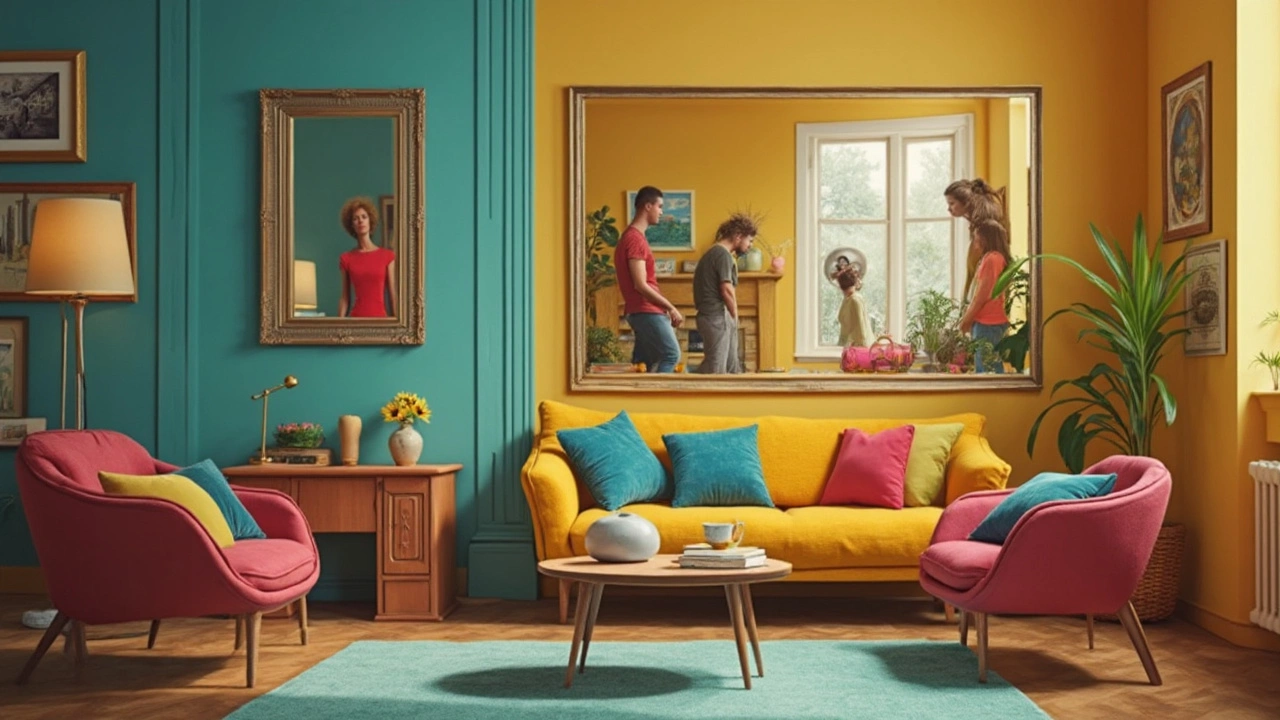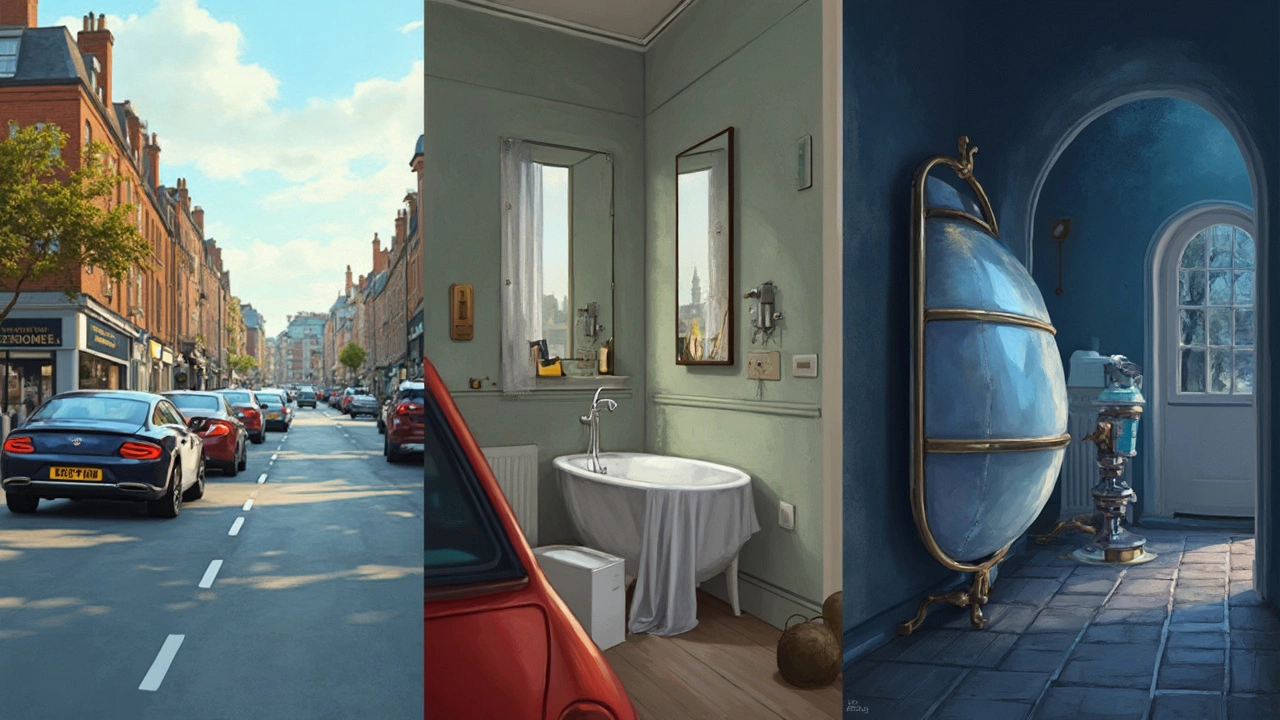Types of Mirrors: The Three You Actually See Everywhere
 May, 20 2025
May, 20 2025
Ever noticed how some mirrors just show you as you are, while others make your head look like a balloon or somehow let you peek around corners? There’s actually a reason for that—it all comes down to the three main types of mirrors: flat, concave, and convex. Each one bends light differently, and that completely changes the picture you see.
Getting this stuff straight is pretty useful. Want to buy a new bathroom mirror? Want to figure out why your car’s side mirror says, “Objects in mirror are closer than they appear”? This is the kind of thing you’ll want to know. These mirror types aren’t just science class daydreams—they pop up at home, in traffic, at the dentist, and yes, in those warped carnival mirrors that mess with your mind.
Once you know what each mirror type actually does, choosing the right one is way less confusing. Plus, you’ll finally have an answer for that question, “Why does my face look huge in this selfie mirror?” Turns out, there’s a real explanation. Let’s break down the basics so you can actually use this info every day.
- Flat Mirrors: Your Everyday Reflection
- Concave Mirrors: Up Close and Personal
- Convex Mirrors: Seeing the Wider Picture
- Weird Effects and Funhouse Tricks
- Choosing the Right Mirror for You
Flat Mirrors: Your Everyday Reflection
If you’ve ever looked in the bathroom mirror, checked your look before heading out, or used your phone for a quick face check, you’ve used a flat mirror. Technically called a plane mirror, this is easily the most common type out there. They’re everywhere—bedroom closets, elevators, public restrooms, and store fitting rooms. Flat mirrors have a surface that’s perfectly straight, no curves at all. The main job of a flat mirror is pretty simple: it reflects light back at the same angle it hits, so your reflection looks just like the real you, just flipped left-to-right.
Flat mirrors have been around for thousands of years, but the classic glass-and-metal combo showed up in the 1800s. Modern flat mirrors are made from a sheet of clear glass with a super-thin layer of reflective metal (usually aluminum or silver) applied to the back. This makes them crisp and accurate—so you can trust you’re seeing yourself, not some warped version.
Here’s something you might not know: a standard flat mirror doesn’t actually flip your image up-down or front-back, it only does side-to-side. That weird feeling when you see text or your own writing in the mirror? That’s why it looks backwards. But no magnification or shrinking happens—your face will look the same size as in real life if you stand at arm’s length.
Check out the basics in this table, just to keep it straight:
| Mirror Type | Main Use | Image Properties |
|---|---|---|
| Flat mirror | Everyday personal grooming, bathrooms | Undistorted, same size, reversed left-to-right |
If you’re buying a mirror for your house, especially for a bathroom or hallway, flat mirrors are the go-to. They’re reliable because they give you a true-to-life image—great for applying makeup, shaving, or just checking your hair. Want a trick? The bigger the mirror, the larger the field of view. That’s why some people install wide, wall-sized mirrors in gyms—they give you a view of your whole body, no matter where you’re standing in the room.
No special care needed, either. Just keep your flat mirror clean with glass spray and a soft cloth to avoid streaks and fingerprints. If you notice a mirror in your house starting to look dull or spotted, that’s usually the metal backing breaking down. Time for a new one!
Concave Mirrors: Up Close and Personal
If you’ve ever leaned over a makeup mirror and thought, “Why can I see every pore on my nose?”—you’ve just met a concave mirror. These mirrors are curved inward, kind of like the inside of a bowl. That shape pulls light rays together (fancy term: convergence), which means whatever’s in just the right spot looks bigger and super clear. That’s why makeup mirrors, dentist tools, and even some shaving mirrors use this trick.
Concave mirrors aren’t just for home use—they crop up all over the place. Here’s where you’ll usually bump into them:
- Makeup and shaving mirrors: They make your face look bigger so you can see details.
- Dentist mirrors: Same idea, but so dentists can spot tiny issues inside your mouth.
- Car headlights and flashlights: The mirror focuses light into a strong beam that goes farther.
- Telescope and satellite dishes: They gather light (or signals) from far away.
The key thing is distance. Hold your face too close, and your image flips upside down! That’s a weird effect called “real image inversion.” At a certain ‘focal point,’ the image gets blurry or wonky—a common surprise if you don’t know what to expect.
Here’s a quick table to show how image size and orientation change depending on how far you stand from the concave mirror:
| Distance from Mirror | Image Size | Image Orientation |
|---|---|---|
| Closer than focal point | Bigger | Upright |
| At focal point | Super blurry | None (No clear image) |
| Farther than focal point | Smaller | Upside down |
When it comes to the types of mirrors you’ll actually use to look at yourself in detail, nothing beats a concave mirror. Next time you see one, check out the distance tricks—it’s a great way to see the science in action. Just remember: for a close-up, keep your face between the mirror and its focal point or the whole world turns upside down.

Convex Mirrors: Seeing the Wider Picture
If you’ve ever checked your car’s side mirror and noticed how you can see so much more of the road than in your bathroom mirror, you’re looking at a convex mirror in action. Unlike flat mirrors, convex mirrors curve outward. This outward curve bounces light outwards, shrinking the reflection but letting you see way more in one glance. It isn’t magic—it’s just basic physics.
This is why you’ll find convex mirrors everywhere people need a "wider view." Here’s where you spot them most often:
- Car side and rear-view mirrors
- Safety mirrors in stores (helps catch shoplifters!)
- Mirrors at intersections or parking garages
- ATMs and checkouts, so you can see who’s behind you
One super common label on these is "Objects in mirror are closer than they appear." That’s the downside—things look smaller and further away than they really are. It’s the price you pay for seeing such a wide area.
Take a look at some quick facts:
| Convex Mirror Uses | Why It Matters |
|---|---|
| Car side mirrors | Minimizes blind spots for safer driving |
| Store security | Lets staff monitor larger spaces |
| Parking lots/intersections | Helps prevent accidents by boosting visibility |
| Public transport | Gives drivers a better view of passengers boarding |
Here’s a tip: If you’re installing a mirror outside your driveway or garage, go for a convex mirror. It’ll give you a much better shot at spotting pedestrians, bikes, or cars coming from tricky angles.
Weird Effects and Funhouse Tricks
Here’s the deal: you know those mirrors at places like amusement parks, the ones that turn your body into something out of a cartoon? They’re not random. The secret is all in how the glass curves.
Most carnival mirrors are either concave, convex, or sometimes a mix. A concave mirror (curves inward, like the inside of a bowl) can make your body look stretched out or super tall, depending on how it’s angled. A convex mirror (bulges out, like the back of a spoon) squashes and widens your reflection—think wider torso, tiny feet. Some mirrors even use both shapes at once for wild effects that really mess with your perception.
It’s the same trick your bathroom scale plays, just with light. Any time a mirror bends inward or outward, it will change your reflection by making light rays meet at a point or spread apart. That’s why your face might look super wide in one spot and squished in another, all with the same mirror.
- Concave mirrors create exaggerated features, so one part of you can look huge and the other small.
- Convex mirrors make things look smaller but let you see more of yourself or the scene around you.
- Combine both, and you get those mirrors that twist your body in two directions at once.
Here’s something most people don’t realize: even a slight curve can cause big changes. Some funhouse mirrors curve only a few millimeters, but that’s enough to drastically warp your image. This trick isn’t just for laughs—stores use convex mirrors to help watch for shoplifting, and city buses rely on them so drivers can see around blind corners.
Check out this quick table on common places you might run into these effects outside carnivals:
| Mirror Type | Where You See It | What It Does |
|---|---|---|
| Concave | Makeup mirrors, telescopes | Magnifies details, focuses light |
| Convex | Car side mirrors, stores | Shows wide area, shrinks image |
| Flat | Bathroom/bedroom mirrors | True reflection, no distortion |
If you ever wondered why your mirrors at home don’t give you the circus funhouse effect, it’s because they’re truly flat—no curve, no tricks. But next time you spot a stretched out or squished version of yourself, you’ll know exactly which type of mirror is to blame.

Choosing the Right Mirror for You
Picking the best mirror for your space or needs comes down to understanding what each type actually does. Not all mirrors are created equal, and the wrong type can totally mess up something as simple as a bathroom selfie or as important as your safety on the road.
- Flat mirrors are all about accuracy. You see them everywhere—bathrooms, bedrooms, even fitting rooms at the mall. These are your go-to for shaving, makeup, or whenever you want a true reflection. For most indoor spaces, flat mirrors are the reliable choice.
- Concave mirrors curve inward like the inside of a bowl. They’re perfect for situations where you want to see a bigger or magnified version of something up close, like your face. That’s why you see these in makeup mirrors or shaving mirrors. Just keep in mind, if you stand too far back, the image can flip upside down and stretch out. These also show up as the bright, focused spot on solar cookers or in telescopes, because they gather and focus light really well.
- Convex mirrors curve outward and give you a wide-angle view. This makes them super useful in places where you need to see more, not just what’s right in front of you. Think car side mirrors, store security mirrors, or street corners. Things look smaller and farther away, but you can actually see way more with one.
So, how do you choose? Start by asking yourself where the mirror’s going and what you’ll use it for. Is it for basic grooming? Stick with flat. Need a close-up for details or a splash of extra light? Go with concave. Trying to boost safety or keep an eye on a wide area? Grab a convex mirror.
If you’re looking to buy a mirror online or in a store, check the product description or the shape. If it's flat and thin, it’s a flat mirror. Bowled in like a cereal spoon? That’s concave. Bulged out? Convex. There's no need to overthink it—knowing these simple differences actually makes buying a mirror a no-brainer.